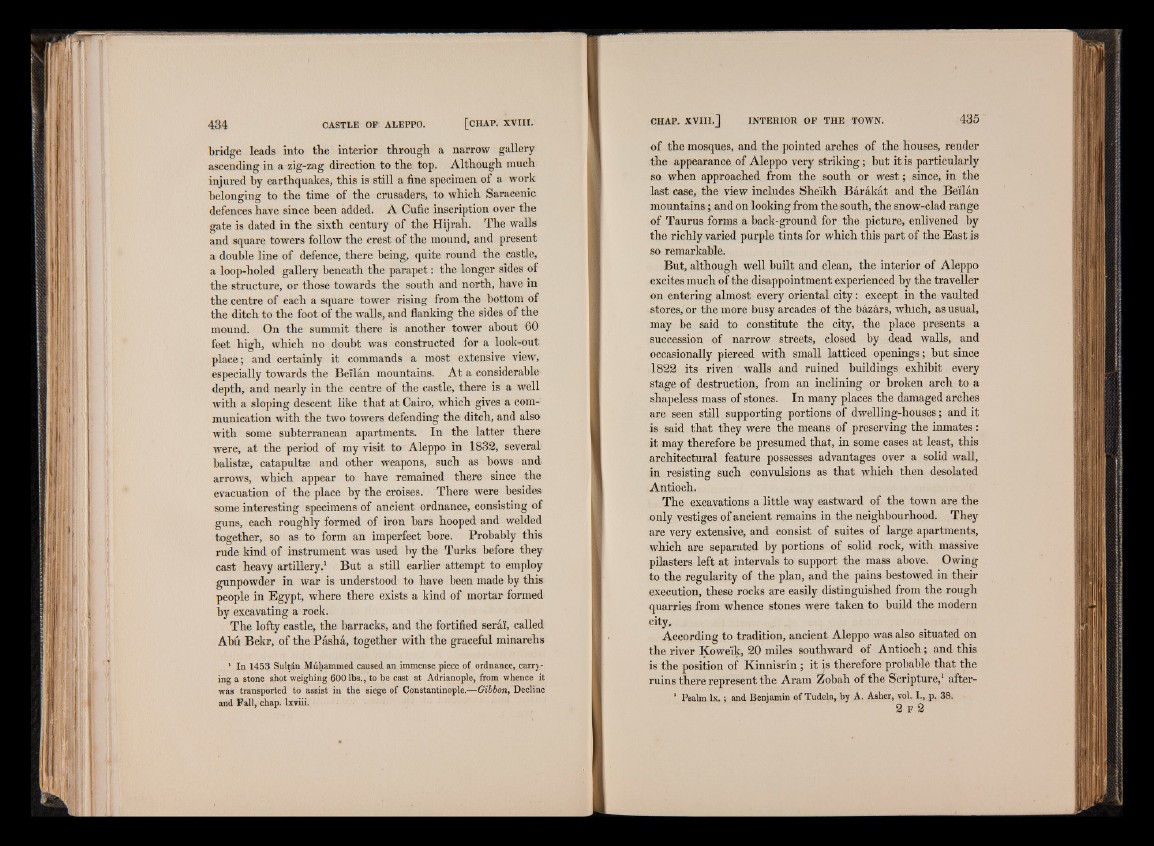
bridge leads into the interior through a narrow gallery
ascending in a zig-zag direction to the top. Although much
injured by earthquakes, this is still a fine specimen of a work
belonging to the time of the crusaders, to which Saracenic
defences have since been added. A Cufic inscription over the
gate is dated in the sixth century of the Hijrah. The walls
and square towers follow the crest of the mound, and present
a double line of defence, there being, quite round the castle,
a loop-holed gallery beneath the parapet: the longer sides of
the structure, or those towards the south and north, have in
the centre of each a square tower rising from the bottom of
the ditch to the foot of the walls, and flanking the sides of the
mound. On the summit there is another tower about 60
feet high, which no doubt was constructed for a look-out
place; and certainly it commands a most extensive view,
especially towards the Beilan mountains. At a considerable
depth, and nearly in the centre of the castle, there is a well
with a sloping descent like that at Cairo, which gives a communication
with the two towers defending the ditch, and also
with some subterranean apartments. In the latter there
were, at the period of my visit to Aleppo in 1832, several
balistse, catapultse and other weapons, such as bows and.
arrows, which appear to have remained there since the
evacuation of the place by the croises. There were besides
some interesting specimens of ancient ordnance, consisting of
guns, each roughly formed of iron bars hooped and welded
together, so as to form an imperfect bore. Probably this
rude kind of instrument was used by the Turks before they
cast heavy artillery.1 But a still earlier attempt to employ
gunpowder in war is understood to have been made by this
people in Egypt, where there exists a kind of mortar formed
by excavating a rock.
The lofty castle, the barracks, and the fortified serai, called
Abu Bekr, of the Pasha, together with the graceful minarehs
1 In 1453 Sultdn Muhammed caused an immense piece of ordnance, carrying
a stone shot weighing 600 lbs., to be cast at Adrianople, from whence it
was transported to assist in the siege of Constantinople.—Gibbon, Decline
and Fall, chap. Ixviii.
of the mosques, and the pointed arches of the houses, render
the appearance of Aleppo very striking; but it is particularly
so when approached from the south or west; since, in the
last case, the view includes Sheikh Barakat and the Beilan
mountains; and on looking from the south, the snow-clad range
of Taurus forms a back-ground for the picture, enlivened by
the richly varied purple tints for which this part of the East is
so remarkable.
But, although well built and clean, the interior of Aleppo
excites much of the disappointment experienced by the traveller
on entering almost every oriental city: except in the vaulted
stores, or the more busy arcades of the bazars, which, as usual,
may be said to constitute the city, the place presents a
succession of narrow streets, closed by dead walls, and
occasionally pierced with small latticed openings; but since
1822 its riven walls and ruined buildings exhibit every
stage of destruction, from an inclining or broken arch to a
shapeless mass of stones. In many places the damaged arches
are seen still supporting portions of dwelling-houses; and it
is said that they were the means of preserving the inmates :
it may therefore be presumed that, in some cases at least, this
architectural feature possesses advantages over a solid wall,
in resisting such convulsions as that which then desolated
Antioch.
The excavations a little way eastward of the town are the
only vestiges of ancient remains in the neighbourhood. They
are very extensive, and consist of suites of large apartments,
which are separated by portions of solid rock, with massive
pilasters left at intervals to support the mass above. Owing
to the regularity of the plan, and the pains bestowed in their
execution, these rocks are easily distinguished from the rough
quarries from whence stones were taken to build the modern
city.
According to tradition, ancient Aleppo was also situated on
the river Koweik, 20 miles southward of Antioch; and this
is the position of Kinnisrin ; it is therefore probable that the
ruins there represent the Aram Zobah of the Scripture,1 after-
1 Psalm lx .; and Benjamin of Tudela, by A. Asher, vol. I., p. 38.
2 F 2